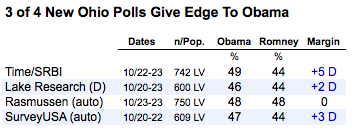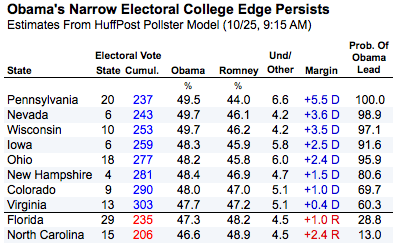WASHINGTON -- New polls released on Wednesday and Thursday continue to show President Barack Obama holding narrow leads in a handful of critical battleground states, but running within a whisker of Republican presidential nominee Mitt Romney nationwide.
While Romney gained significantly in the wake of the first presidential debate in early October, the lack of a continuing trend over the past two weeks helps counter a theme in some campaign coverage that Romney's support continues to "surge" nationwide.
The most recent updates of the seven daily national tracking polls continue to split in terms of which candidate holds the nominal lead, ranging from a 4 percentage-point lead for Romney on the Rasmussen Reports automated tracking to a 3 point Obama advantage on the Investor's Business Daily/TIPP poll.
![]()
Separately, a new Associated Press/GfK survey released on Thursday morning showed Romney with a 2 percentage-point edge over Obama (47 to 45 percent).
The HuffPost Pollster tracking model, which combines data from both national and statewide polling to create a combined estimate, continues to show a near tie, with just two-tenths of one percent separating Romney (47.1 percent) and Obama (46.9 percent) as of this writing. The model currently reports just 56 percent confidence that Romney is actually leading the national popular vote; slightly better than a coin-toss, but just barely.
Although their methodologies and estimates of the leader vary considerably, these national tracking polls provide a useful gauge of late trends, since they collectively interview over 2,000 voters a day. Their most recent releases show no signs of Romney momentum. Three ticked in Obama's direction, three were unchanged and one moved toward Romney.
Wednesday also brought four new surveys in Ohio. Three of the four, from Time, SurveyUSA and Democratic pollster Lake Research, gave Obama leads ranging from 2 to 5 percentage points while the Rasmussen automated survey reported a tie.

The new results have little impact on the Ohio trend chart produced by the Pollster model, which continues to give Obama an advantage of just over 2 percentage points. Although that lead is narrow, the volume of polling in Ohio boosts the model's confidence that Obama is running ahead there to 96 percent.
Collectively, the new polls of the past 24 hours have done nothing to change the standings in the most crucial battleground states. Obama continued to hold leads of 2 to 3 percentage points in Ohio, Iowa, Nevada and Wisconsin, four states that currently combine with the states where Obama leads by larger margins to create a 277 electoral vote majority, seven more than the 270 needed to win.

Romney continues to lead in North Carolina and retain a narrow edge in Florida, states that would net him 233 electoral votes along with other states where Romney leads by larger margins. Those totals leave 26 electoral votes up for grabs in New Hampshire, Colorado and Virginia, states where the tracking model shows Obama leading by very narrow margins of 2 percentage points or less.
Collectively, the trends of the past week provide a reality check to two myths that have emerged in recent campaign coverage.
The first is that Romney has been "surging" since the first debate. While the debate certainly boosted Romney's standing in the polls, trends over the past two weeks have been negligible, with the leader seesawing nationally within a range of roughly one percentage point. Over the same period, the standings within the key battleground states have also remained constant. Other poll tracking models have shown the same patterns.
The second myth is that the national and battleground states polls have produced widely divergent results. If we use the state estimates produced by the Pollster tracking model in the nine key battlegrounds (Iowa, Wisconsin, Nevada, Ohio, New Hampshire, Colorado, Virginia, Florida and North Carolina) to create a combined total vote based on the turnout in each state in 2008, we show Obama leading in across all nine states by a slim 0.6 percentage point margin (47.8 to 47.2 percent as of this writing; the estimated margin would be 47.9 to 47.2 percent if based on the 2004 turnout).
Romney does slightly better in the national popular vote estimate, of course, but his 0.2 percentage point advantage there is only slightly better. The net gap is less than a percentage point.
As the Cook Political Report's David Wasserman writes on Twitter, simply subtracting 4 percentage points from Obama's 2008 margins in each state produces a similar result: "He'd lose Popular vote by 0.7% but still win w/ 272 EC votes."
The differences may appear bigger because Obama's advantages are spread across a number of relatively small battleground states that, except for Ohio, all have 10 or fewer electoral votes. Romney stays close in the combined battleground state estimate mostly because his three best states -- Florida, North Carolina and Virginia -- represent just over half (51 percent) of the combined battleground vote.
So yes, the potential exists for a divided outcome, with Obama winning the Electoral College and Romney winning the popular vote, but such an outcome would be, as it was 12 years ago, a game of inches, not yards.

